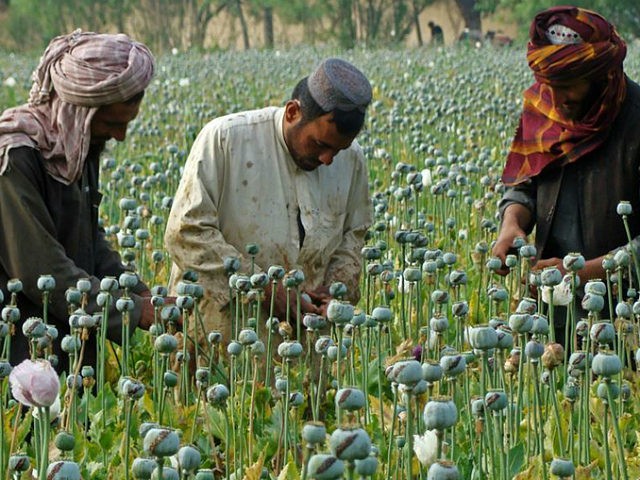The historic production of opium and its heroin derivative in Afghanistan — with a record output value of up to $6.6 billion last year, or nearly a third of the country’s entire gross domestic product — appears to provide better prospects for job security than any other industry in the nation.
In 2017, Afghanistan produced an unprecedented 9,000 metric tons of opium, capable of producing up to 900 tons of export-quality heroin, according to the U.S. government and United Nations.
“The value of 2017’s opium output was between $4.1 billion and $6.6 billion, or equivalent to 20 to 32 percent of Afghanistan’s entire gross domestic product,” John Sopko, the U.S. Inspector General for Afghanistan Reconstruction (SIGAR), declared Thursday.
The opium industry currently supports “up to 590,000 full-time jobs — a number substantially higher than the entire strength of the Afghan army and police forces,” a SIGAR report, titled “Counternarcotics: Lessons from the U.S. Experience in Afghanistan,” revealed this week.
In a speech announcing the release of the report, which covers America’s failed counternarcotics efforts, Sopko noted, “Opium poppy production has become so ingrained in the livelihood of many Afghans, that it may provide the equivalent of up to 590,000 full-time jobs — a number substantially higher than the entire strength of the Afghan army and police forces.”
Echoing the inspector general, Vanda Felbab-Brown, an Afghanistan expert from the Brookings Institution, proclaimed late in 2017 that the illicit opium industry is the top job producer in the country and will remain so for years to come.
“Although the illicit drug economy exacerbates insecurity, strengthens corruption, produces macroeconomic distortions, and contributes to drug use, it also provides a vital lifeline for many Afghans and enhances their human security. There is simply nothing in Afghanistan that produces more jobs than the opium poppy economy, or could do so in the foreseeable future,” she said.
The United States has devoted about $8.6 billion to counternarcotics efforts in Afghanistan since the U.S. invaded the country in 2001, but the country remains the world’s top producer of the two drugs.
Moreover, the efforts have only made a minuscule dent to the opium and heroin business, which the U.S. military has repeatedly said generates up to 60 percent of the Taliban’s revenue.
“The amount of opium seized over the last ten years is equivalent to about 5 percent of the estimated opium production in 2017 alone,” Sopko said Thursday adding:
To put it bluntly, these numbers spell failure. … Afghanistan’s narcotics sector continues to fuel insurgent violence and foster corruption throughout the Afghan government. The opportunity to profit from the opium trade has resulted in alliances between corrupt government officials, drug traffickers, and insurgents. Opium has been described as providing “the economic glue which binds together political coalitions.
Sopko noted that it is difficult to gauge U.S. President Donald Trump’s efforts against the unprecedented production of opium in Afghanistan.
Marking a significant departure from his predecessors, Trump authorized the U.S. military to begin targeting heroin labs with airstrikes.
“As of late 2017, these financing estimates underpinned assumptions about the potential benefits of a costly air interdiction campaign that carried risks of civilian casualties,” SIGAR reported. “Without a clear understanding of how insurgents benefit from and participate in the narcotics trade, particularly at local levels, it is difficult to measure the effectiveness and impact of this campaign.”

COMMENTS
Please let us know if you're having issues with commenting.